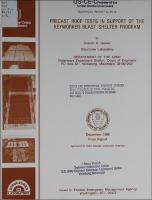Please use this identifier to cite or link to this item:
https://hdl.handle.net/11681/11185| Title: | Precast roof tests in support of the Keyworker Blast Shelter Program |
| Authors: | Keyworker Blast Shelter Program United States. Federal Emergency Management Agency Garner, Sharon B. |
| Keywords: | Blast effects Explosion effects Nuclear bomb shelters Precast concrete Keyworker Blast Shelter Program Buried structures Underground structures |
| Publisher: | Structures Laboratory (U.S.) Engineer Research and Development Center (U.S.) |
| Series/Report no.: | Technical report (U.S. Army Engineer Waterways Experiment Station) ; SL-86-43. |
| Description: | Technical Report Abstract: Tests were conducted to investigate the capacity of precast simply supported roof panels to withstand a design overpressure of 50 psi from a 1-MT nuclear detonation. Another purpose of the study was to determine what part, if any, soil arching plays in increasing the load capacity of a shallow-buried, simply supported roof. Nine roof elements of three different thicknesses were tested in three separate events. Test 1 roof slabs (2-1/2 inches thick) showed no visible cracking and no permanent downward deflection. Test 2 slabs (2 inches thick) showed cracks at midspan on the top side of both end panels and on the underside of one end panel. Test 3 slabs (1-1/2 inches thick) experienced greater midspan deflections than the slabs in the previous tests. Analysis of the test results indicates that thin precast roof elements are viable alternatives to a cast-in-place roof. Roof capacity was enhanced by soil arching. |
| Rights: | Approved for public release; distribution is unlimited. |
| URI: | http://hdl.handle.net/11681/11185 |
| Appears in Collections: | Technical Report |
Files in This Item:
| File | Description | Size | Format | |
|---|---|---|---|---|
| TR-SL-86-43.pdf | 23.88 MB | Adobe PDF |  View/Open |